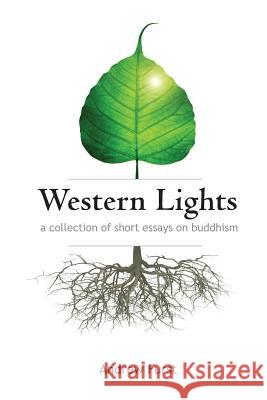Western Lights: A Collection of Essays on Buddhism » książka
Western Lights: A Collection of Essays on Buddhism
ISBN-13: 9780615675817 / Angielski / Miękka / 2014 / 120 str.
"Personal experience has proven that my body has to do nothing short of screaming to get my attention. In my mid-thirties I was working sixty plus hours per week. I loved the opportunity, I wanted the money, but then came the back spasms.... And that was the alarm that I needed. The lightening had struck. It was time for change." Andrew Furst W e s t e r n L i g h t s BUDDHISM is an ancient eastern tradition steeped in the culture of India, China, Tibet, Thailand, Korea, and Japan. It's still acquiring its form and voice in the west. For Americans to benefit from its wisdom, it needs to find a place in our hearts and minds. Western Lights is a collection of essays from the viewpoint of a Western Buddhist teacher. It speaks about Eastern concepts like karma, hope, attachment, and amptiness from a personal perspective and in terms familiar to Americans. They're grounded in subject matter familiar to Americans like politics, science, psychology, heaven, and nature. I hope to help the reader find a personal connection to this ancient tradition and discover what it has to say about the challenges of contemporary life. INTRODUCTION This collection of short essays was gleaned from my first foray into writing- blogging for the Buddhist Meditation Group at the Unitarian Universalist Church of Reading. To those looking for insight on the path to writing a book, this was my route. In many ways, this book is a selfish venture. It has allowed me to see how everything and everyone are the Buddha teaching me. Writing has also allowed me to see my mind, mostly its cluttered nature, and to both adore it and strive to discipline it. The blog has steered most recently onto the themes of naturalness, rhythms, and insights available in everyday life. I've strived to dust off the dry academic and culturally oriental tenets of this precious 2,500-year-old religion and bring it to life. I've tried to do this by putting it through the agitator of the frenetic beat of western life and the wringer of the western reductionist mind. The attempt is to take the familiar and spin it on its head in the hopes that I lure you, shake up your world view, and leave you with a little to chew on. 1 What is the Single Most IMPORTANT Teaching? I had the opportunity to speak with students at Middlesex Community College in Bedford Massachusetts. I was invited by the professor to speak to a class on world art and literature about Buddhism. There were several delightfully engaged students. One of them posed the following question: Could you expand upon how Pure Land Buddhism differs from other schools? And what is its single most important teaching? Answer: Pure Land Buddhism rests on three pillars: FAITH, VOWS, PRACTICE. A Short Meditation Meditation is the unification of body, breath, and mind. During this brief session I encourage you to leave everything else behind. Let's start with the body. Find a comfortable sitting posture or even lie down. You want to be able to relax all the big muscles in your body. Close your eyes or keep them open as you feel most comfortable. Spend a minute to reacquaint yourself with all your parts. Take a deep inhale in and with a slightly exaggerated exhale, release all the muscles of your body. Sink. Let all of your flesh literally hang off of your bones. For the next five breaths allow this sense of relaxation to deepen, letting go a little more with each exhale. Nowwe'llsynchronizethebreathandthemind.Youcanchoosetochant silently or out loud (I recommend out loud - think Gregorian Chant). Either way start with a deep inhale. On the exhale, chant Namo Amitofo slowly for the length of the breath. Inhale again, and exhale Namo Amitofo. If your chanting aloud, use a deep low tone. Feel the vibration from your throat and heart. Allow it to expand up and down your spinal column. If you're chanting silently, allow the words to permeate through your entire body.











